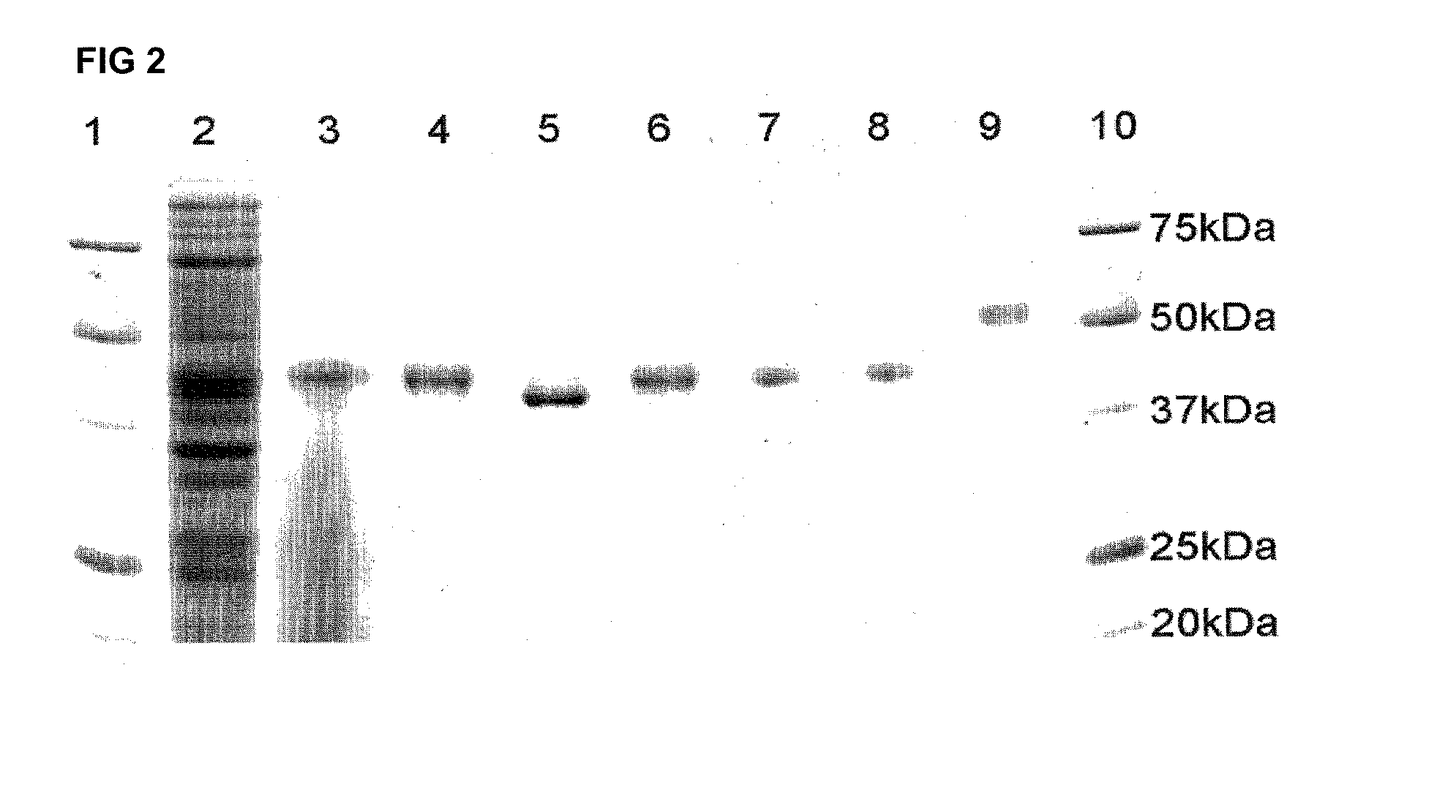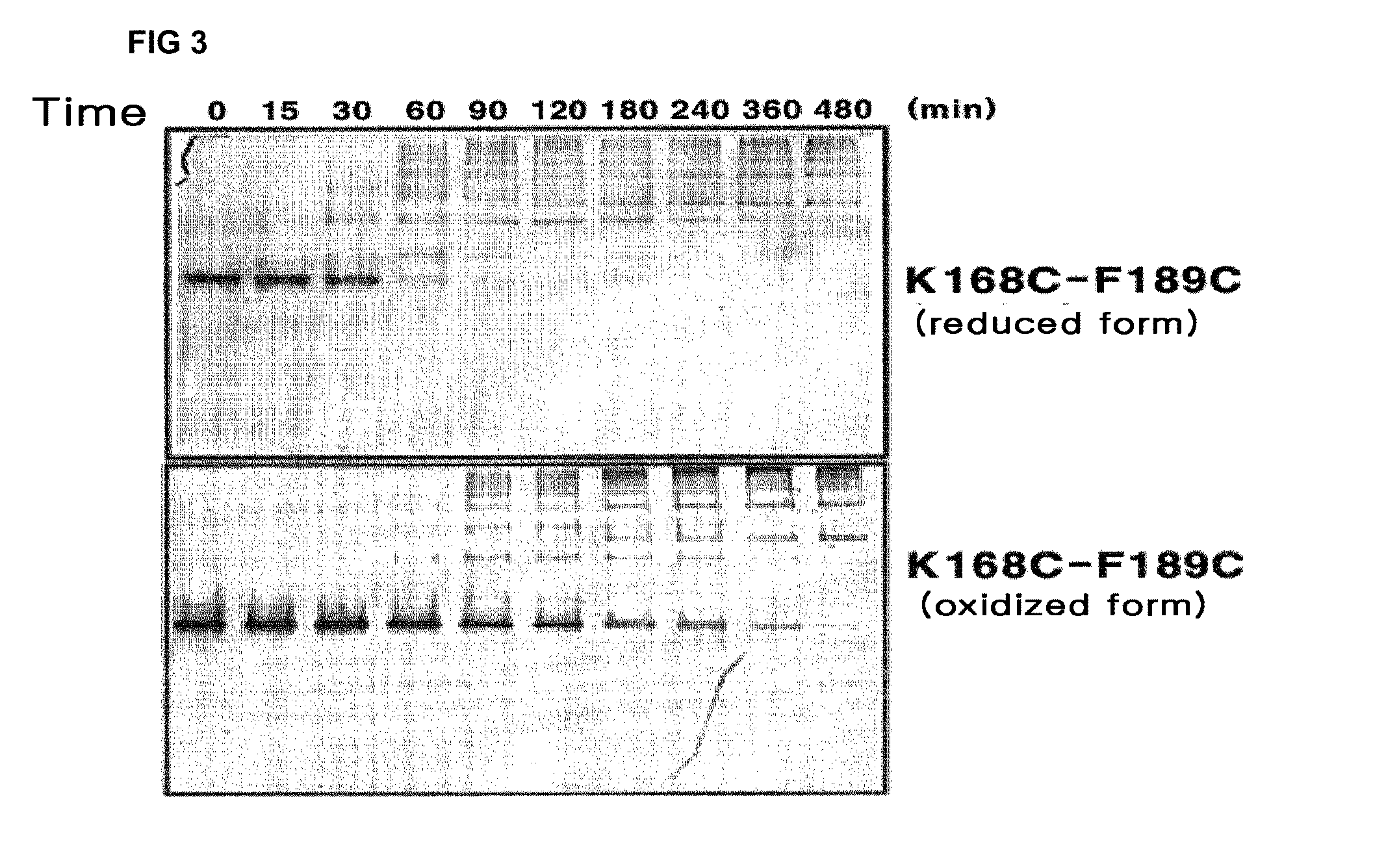Thermostable alpha1-antitrypsin mutein with a disulfide bond and the method for preparing it
- Summary
- Abstract
- Description
- Claims
- Application Information
AI Technical Summary
Benefits of technology
Problems solved by technology
Method used
Image
Examples
reference example 1
[0064]32 positive clones were obtained from human liver cDNA library (Clontech, U.S.A) by using the nucleotide number 50-72 probe among nucleotide sequences reported by Long et al. (Long et al., Biochemistry 23, 4828 (1984)), which were narrowed down to 4 positive clones by suing the nucleotide number 1150-1172 probe. pUC-AT(R) was obtain therefrom and AT gene was 1.3 kb fragment cut by EcoRI or BamHI.
[0065]More details are described in the reference paper of Lee and Yu (Lee and Yu, Journal of Biochemistry and Molecular Biology 22, 148 (1989)), which is included in this description as a reference.
reference example 2
Expression of Wild Type Recombinant AT
[0066]The pUC-AT(R) prepared in Reference Example 1 was digested with BamHI to obtain 1.3 kb fragment, which was inserted into BamHI site of pET-8c plasmid (Studier and Moffatt. J. Mol. Biol, 189, 112 (1986)) to construct pEAT 8. E. coli BL21(DE3) was transformed with the pEAT 8 and the expressed AT was named as wild type E. coli recombinant AT. The wild type E. coli recombinant AT polypeptide contains methionine as the first residue of amino acid sequence, while human blood plasma originated AT contains glutamate as the first amino acid residue. However, the remaining residues from the second residue were same as those of wild type AT (FIG. 1).
[0067]The amino terminal sequence of the wild type recombinant AT was confirmed by protein sequencing (Applied Biosystem 477A was used). The E. coli transformed with pEAT 8 was deposited at Korean Collection for Type Cultures on Apr. 17, 1991 (Accession No: KCTC 0009BP).
[0068]The details on this example a...
manufacturing example 1
Construction of a Transformant Containing a Gene Substituted to Produce Thermostable AT
[0069]Site specific mutagenesis was induced according to the modified PCR developed by EcKert et al. (Eckert and Kunkel, PCR Chap. 14, The fidelity of DNA polymerase chain reactions, ed. by McPharson et al., Oxford Univ. Press (1991)). Particularly, a primer (approximately 30 mer) was designed to have single stranded DNA obtained from pEAT 8 plasmid prepared in Reference Example 2 and the substituted codon corresponding to the amino acid in the center, and used for the site specific mutagenesis according to the method of Kunkel (Kunkel, Methods in enzymol. 154. 367-382 (1987)). The mutation was confirmed by nucleotide sequencing.
[0070]E. coli BL21(DE3) was transformed with the constructed plasmid and then mutant strain was obtained from the colony having ampicillin resistance.
PUM
| Property | Measurement | Unit |
|---|---|---|
| Length | aaaaa | aaaaa |
| Length | aaaaa | aaaaa |
| Length | aaaaa | aaaaa |
Abstract
Description
Claims
Application Information
 Login to View More
Login to View More - R&D
- Intellectual Property
- Life Sciences
- Materials
- Tech Scout
- Unparalleled Data Quality
- Higher Quality Content
- 60% Fewer Hallucinations
Browse by: Latest US Patents, China's latest patents, Technical Efficacy Thesaurus, Application Domain, Technology Topic, Popular Technical Reports.
© 2025 PatSnap. All rights reserved.Legal|Privacy policy|Modern Slavery Act Transparency Statement|Sitemap|About US| Contact US: help@patsnap.com



